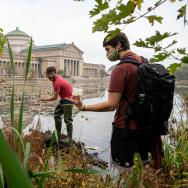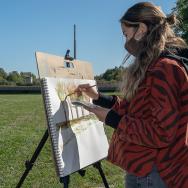Over the past several months, University of Chicago students and scholars have found ways to build connections under unusual circumstances—in some cases, taking the idea of “build” literally.
From constructing a virtual version of the Hyde Park campus, to creating new sculptures on its real-life counterpart, the pandemic has prompted new ways to think about community. That has held true in classes and programs as well, whether the focus is the beautiful possibilities of dance, or pondering the end of the world. As the academic year draws to a close, here’s a quick look at some of what UChicago has learned, together.
Gathering, from afar
For much of the past year, strolling the quad and chatting with friends in the Reg felt like joys of the past. Enter Gather Town, an online experience that replicates the genuine human interaction that students, faculty and staff miss. Through a multitude of unique features, Gather Town simulates the real UChicago campus—from exploring the Quad, to coffee meet-ups with friends, to impromptu card games.
The UChicago launch of Gather Town was spearheaded by historian Ada Palmer, whose annual Italian Renaissance course has students reenact a papal election. Palmer’s friends suggested the platform as a way to virtually recreate Rockefeller Chapel, which serves as the reenactment setting for the Sistine Chapel.
“Zoom can’t enable circulating through a space, ducking out for a private conversation or walking to the middle of the room and suddenly making a big announcement, but Gather Town can handle those things,” said Palmer, associate professor of early modern European history and the College. “As I looked into what it would take to make Rockefeller, I thought of how many other things—like receptions, dorm groups, RSOs, conference receptions, even a game like Humans v. Zombies—might be able to make use of it.












 —Prof. Kunle Odunsi
—Prof. Kunle Odunsi
